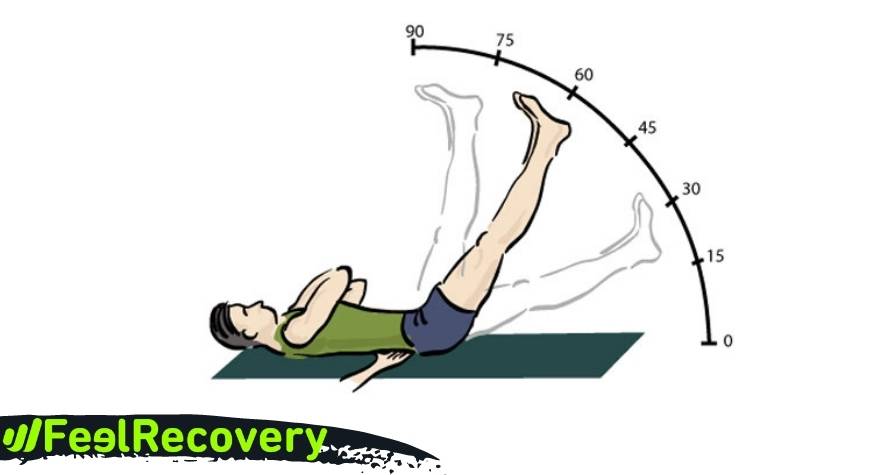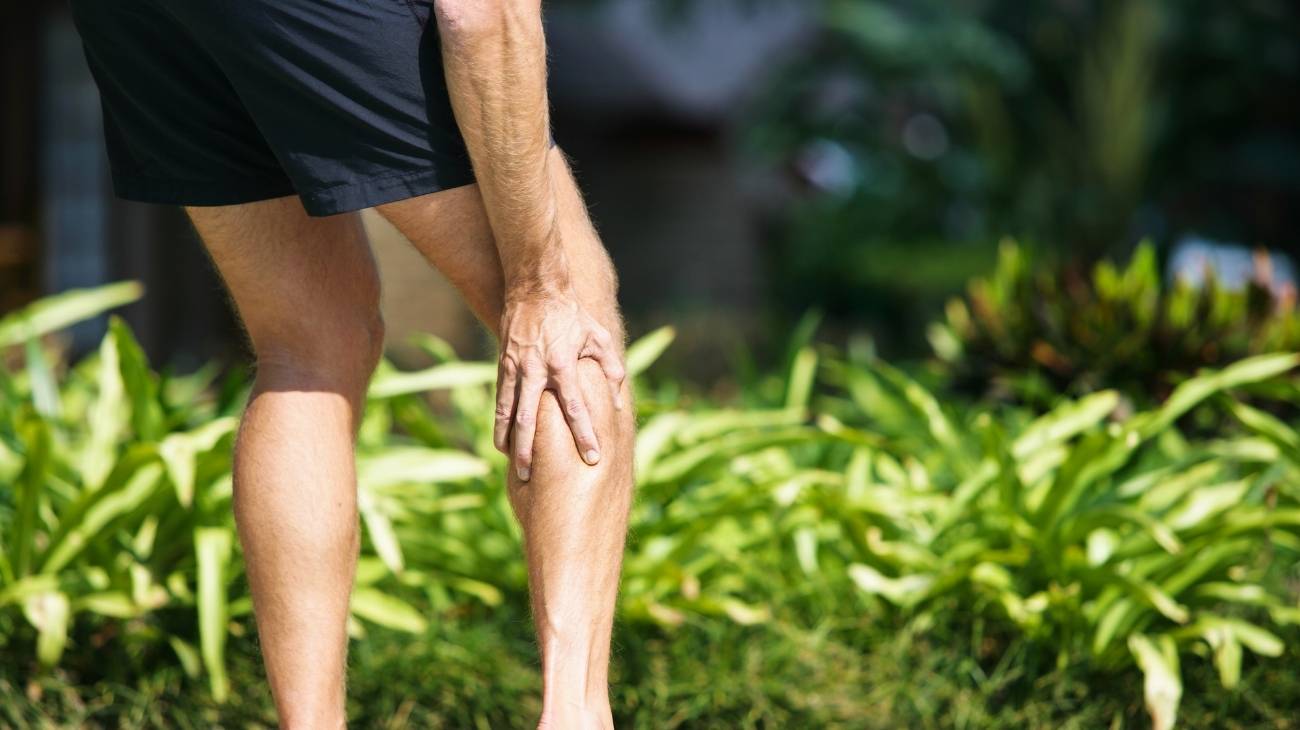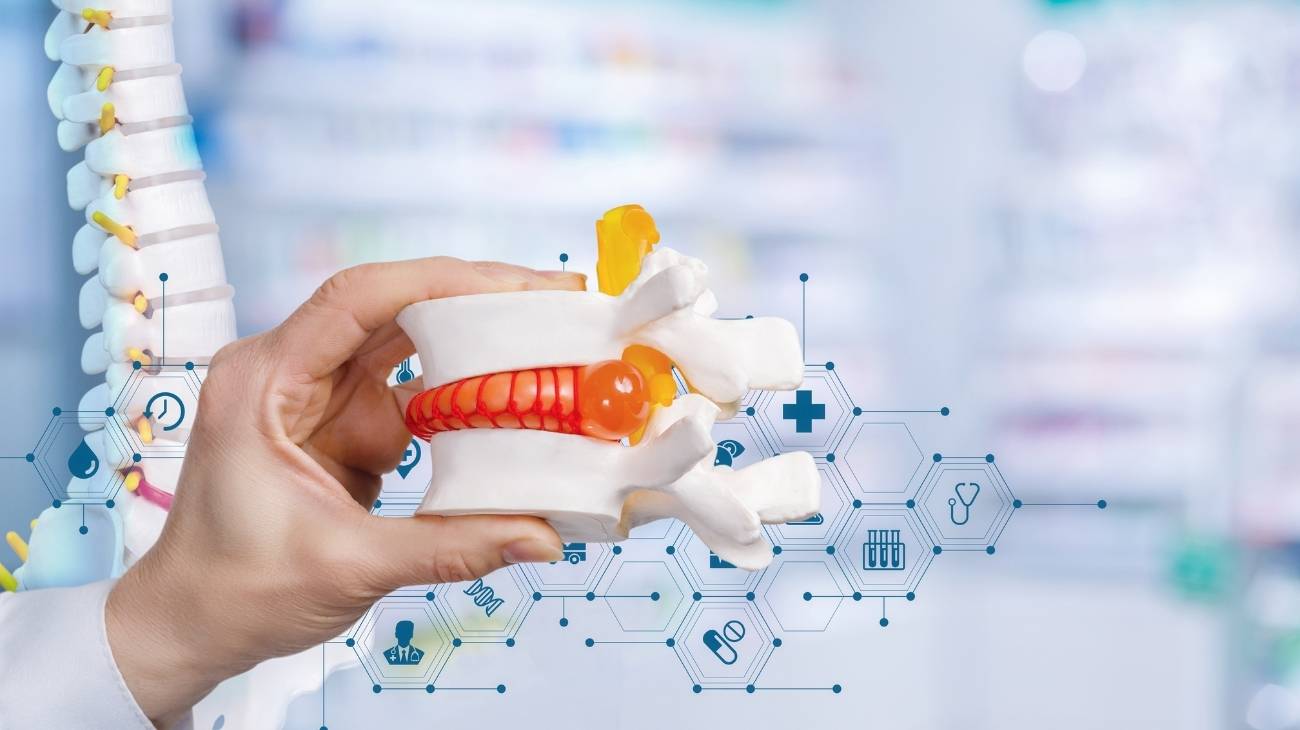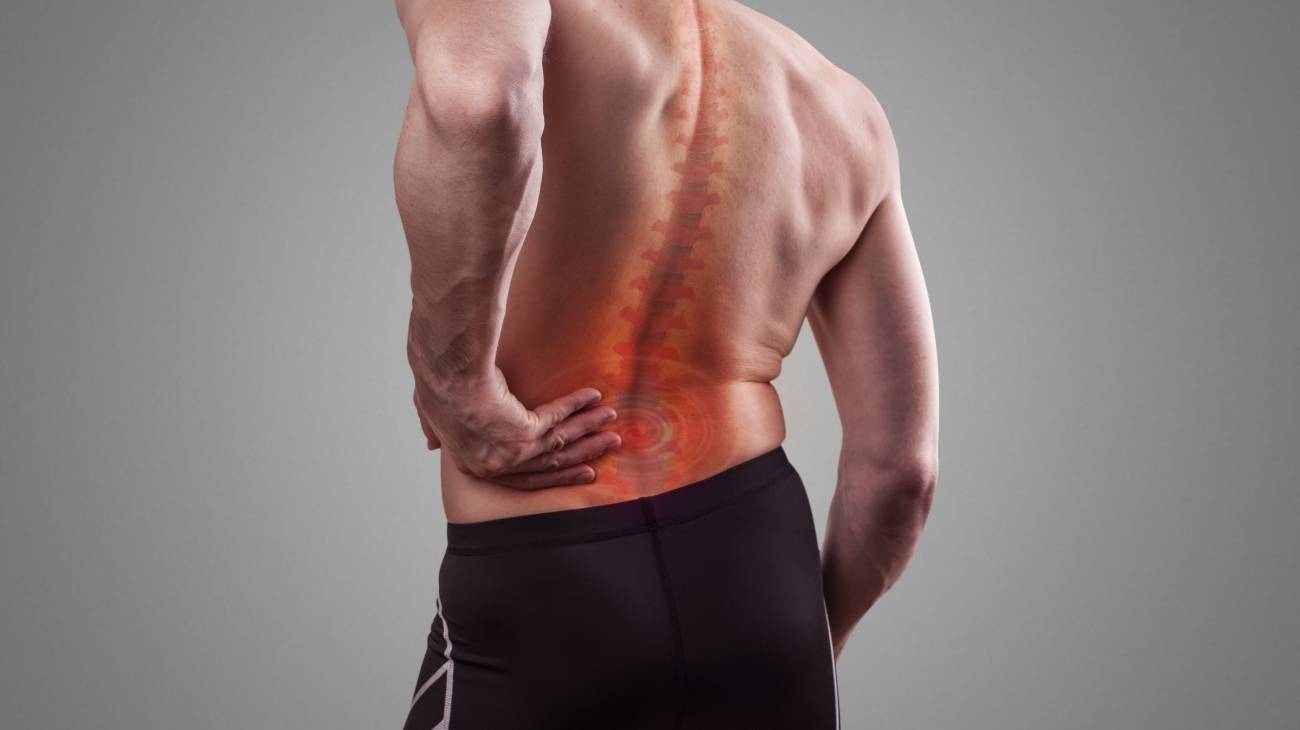- Definition: What is a lumbar or cervical disc herniation?
- What are the most common types of hernias?
- Best products for back pain relief
- What are the causes and risk factors for herniated discs?
- Main signs and symptoms that warn us that we have a herniated disc
- What tests are available to diagnose the onset of a herniated disc?
- What treatments are available to relieve herniated disc pain in the back?
- What are the forbidden exercises if we suffer from a herniated disc?
- What are the sports and activities that can be practised with a herniated lumbar or cervical disc?
- F.A.Q: Frequently asked questions
The spine of the human body is made up of vertebrae, and between them are discs. When a herniated disc occurs, these discs become deformed, rupture or shift, putting pressure on the nerves in the back.
We invite you to learn everything you need to know about herniated discs, one of the most common injuries in old age and when practising high-impact sports. Learn about the types of herniated discs and the main symptoms you will notice in your body when you suffer from one. We'll also show you the best diagnostic test to perform in case of pain.
Definition: What is a lumbar or cervical disc herniation?
Medically speaking, a herniated disc is any cartilage lesion in the vertebrae of the spine. These vertebrae are made up of a nucleus and a disc of bone that surrounds it, and when part of this nucleus comes out of its respective annulus, a herniated disc occurs. However, it is also often referred to as a herniated disc when a disc slips out of position and presses on a nerve.
Lumbar herniated discs are the most common because the lower back is the area that takes the full load of the body. Actions such as sitting, standing and bending require skeletal muscle work in the lower back, and if this is not in good condition, the strain is transferred to the vertebrae, making it easier for a hernia to occur. The cervical area is also susceptible to injury from maintaining a poor body position for long hours.
What are the most common types of hernias?
The spine has 7 cervical, 12 thoracic and 5 lumbar vertebrae. Each area of the back responds differently depending on how hard the person is working. Find out about the types of hernia according to the area where the pain is located.
Cervical disc herniation
It is the injury located in the vertebrae that go from the base of the head to the height of the shoulders. This is why it is not correct to say that you have a "lumbar" hernia, as in this case, the patient touches your neck to refer to it. It is the second most common type of hernia in middle-aged and older people.
It is also a fairly common injury in people who sit for long periods of time for work or mobile phone entertainment. Sports such as golf, in which the whole body is twisted to hit the ball, also tend to cause pain in the back of the neck.
Thoracic disc herniation
Of the herniated discs, those that occur in the thorax are the least frequent. They account for only 0.5% of known cases of this type of injury. This is because the vertebrae in this area require the least mobility and are therefore less likely to suffer an injury.
Pain can easily be mistaken for cardiac or pulmonary pathology. It is therefore recommended to perform detailed examinations to rule out any possibility of injury to tissues and muscles before examining the spine and concluding that the discomfort is caused by disc displacement.
Lumbar herniated discs
The five vertebrae in the lower back are the most compromised because they require greater mobility and have greater pressure. Being inactive and the overwork of the lumbar discs causes wear and tear that ends up causing some kind of back problem.
Lifting heavy objects, prolonged sitting or standing, even very intense or long training sessions, will cause your back to overwork and wear out until the discs give way and are injured. Generally, such an injury involves the nerves of the spine, which is an additional complication that often requires surgery.
Best products for back pain relief
Bestseller
-
Microwave Wheat Bag for Back Pain Relief (Extra Large) (Hearts)
£24,95 -
Microwave Wheat Bag for Back Pain Relief (Extra Large) (Oxford)
£24,95 -
Microwave Wheat Bag for Back Pain Relief (Extra Large) (Sport)
£24,95 -
Microwave Wheat Bag for Neck & Shoulder Pain Relief (Hearts)
£24,95 -
Microwave Wheat Bag for Neck & Shoulder Pain Relief (Oxford)
£24,95 -
Microwave Wheat Bag for Neck & Shoulder Pain Relief (Sport)
£24,95 -
Microwaveable Wheat Bag for Pain Relief (Hearts)
£20,95 -
Microwaveable Wheat Bag for Pain Relief (Oxford)
£20,95 -
Microwaveable Wheat Bag for Pain Relief (Sport)
£20,95 -
Wheat Bag for Microwave Classic Bottle Shaped (Hearts)
£20,95 -
Wheat Bag for Microwave Classic Bottle Shaped (Oxford)
£20,95 -
Wheat Bag for Microwave Classic Bottle Shaped (Sport)
£20,95
-
Back Support Belt (Black)
£39,95 -
Back Support Belt (Green)
£39,95 -
Back Support Belt (Pink)
£39,95 -
Ice Massage Roller Ball (Black)
£34,95 -
Ice Massage Roller Ball (Green)
£34,95 -
Ice Massage Roller Ball (Pink)
£34,95 -
Sacroiliac Support Belt (Black)
£24,95 -
Sacroiliac Support Belt (Green)
£24,95 -
Sacroiliac Support Belt (Pink)
£24,95 -
Soft Density Foam Roller for Recovery (Black)
£34,95 -
Soft Density Foam Roller for Recovery (Green)
£34,95 -
Soft Density Foam Roller for Recovery (Pink)
£34,95
What are the causes and risk factors for herniated discs?
Most of the causes of a herniated disc can be avoided by taking preventative measures, whether it's playing sports and knowing your limits, lifestyle habits that affect your health, or occasional activities that put undue stress on your back.
Lifting too much weight
We think that lifting a single heavy box won't affect our health, but that's a mistake. The body must be prepared for excessive physical activity and we don't often pay attention to this detail. When lifting heavy weights from the floor, try to use the strength of your legs to your advantage to reduce the workload on your lower back and prevent the discs from slipping.
If your job involves carrying heavy objects, wear a lumbar compression garment to protect your vertebrae and reduce the risk of injury. When practising sports, warm up your body first, as this is the only way to allow your back to work with less risk of injury.
Overweight
It is up to each person to choose whether or not to take care of their physical condition, which is equivalent to having good health and thus lowering the probability of the back having to bear the pressure of excess body weight. Obesity is the main cause associated with permanent back pain.
The musculoskeletal structure is not prepared to carry a heavy body weight, especially in old age when our musculature is generally weaker. Try to maintain a good Body Mass Index, and give your body a chance to be healthy.
Back twists
Sporting activity is not always healthy, sometimes a bad movement causes the discs to wear down until they start to rupture. This is what happens in sports such as golf and yoga, where the trunk of the athletes must perform intense or excessive twisting. We are not saying that these sports are counterproductive, but that they must be performed with the correct technique in order to avoid problems.
Developing muscle strength and ligament elasticity will be essential to avoid this type of injury. The main protection will be to recognise the limits that each athlete has and to manage the sporting technique correctly, according to the sport they are doing. In many cases, accompanied by lumbar strengthening exercises, it is recommended to use a lumbar belt and take breaks after 45 minutes of continuous work.
Maintaining the same position
The back, like any other part of the body, requires rest and a change of position from time to time. It is just as harmful to sit for long periods of time as it is to stand for long periods of time. The spine was created to be in motion and to support the body weight while the person is moving. In addition, due to fatigue, we tend to adopt wrong positions that cause an imbalance in the spine.
This habit related to postural hygiene, together with other risk factors, makes pain more recurrent. Active breaks only take 10 minutes for every hour of work, so a short break every 45 minutes of activity is recommended to reduce the possibility of aches and pains.
Genetic predisposition
Studies have shown that some people tend to get hernias for genetic reasons. If there is a family history of disc injuries, it is important to take precautions from a young age and modify habits to improve quality of life.
In addition, diseases such as osteoporosis and arthritis will weaken the strength and endurance in the muscles and joints, which will generate a greater workload in the lower back. If there is a genetic predisposition and a bad lifestyle, then the risk of disc injuries increases by 25%. It is therefore important to have frequent medical examinations if there is a known family history of disc lesions.
Tobacco addiction
Studies have shown that smoking doubles the likelihood of back injuries related to spinal discs. This is because as nicotine enters your body, the amount of oxygen reaching the discs in your spine is greatly reduced.
As there is not enough oxygen, the wear and tear is greater in the discs that do not have the required components to resist mobility, and even less so when this is intense, therefore it is recommended that you completely eliminate smoking from your life.
Main signs and symptoms that warn us that we have a herniated disc
Herniated discs have a large number of symptoms that can easily be confused with other injuries and pathologies. That is why you must know precisely how to identify them in order to treat them as soon as possible.
Reduced mobility
Having difficulty moving your arms forward and to the sides is a clear sign that you may have a herniated disc in the thoracic area. This difficulty is more pronounced in the morning, when the body is more relaxed. Sitting, bending down, getting out of bed also becomes difficult when the disc displacement is concentrated in the vertebrae of the lumbar region. Even tossing and turning in bed while sleeping can cause severe pain that is sure to wake you up.
Weakness
Feeling that you tire quickly and that your body is sluggish or weak are also warning signs. Try to take a break if you think it's a minor injury, but with a damaged disc, these signs will persist over time. When a hernia occurs, unless it is treated with physiotherapy, strengthening exercises and, in extreme and advanced cases, surgery, it will not go away on its own, because it is a degenerative condition.
Tingling
If you lose sensitivity to touch and feel as if a slight electric current is running through your spine, pay attention to the area where it starts, as this will tell you in which area of your back the disc lesion may be. If the injury results in compression of the sciatic nerve, the tingling is likely to start in the lower back, buttocks and thighs.
Whereas if the nerve compression is in the middle area, then the numbness will be felt in the arms, hands and fingers. This is a complex sign because it is often confused with other arm complaints. This is why we recommend that you see your doctor or physiotherapist for a more detailed examination.
Pain
In the case of a disc injury, the pain is intense and localised in the affected area. Note that by the time the pain appears, the injury is already quite advanced. Both disc displacements and disc deformities and ruptures will cause you to have shooting pain.
But as a nerve-involved injury, you are also likely to feel radiating pain in other parts of the body, especially the buttocks, legs and arms, depending on the location of the affected disc. Only more detailed medical tests such as CT scans and X-rays can tell whether or not surgery is needed to try to repair the disc damage.
What tests are available to diagnose the onset of a herniated disc?
There are different ways of detecting whether or not a person has a herniated disc:
- Visual and tactile examination of the vertebrae.
- X-rays.
- Computerised tomography.
- MRI scans.
- Rapid tests that will help to get a better picture of what is happening.
In this section, we will refer to the test called the "Lasègue test" which should be carried out by a physiotherapist after you have already suffered for some time with back discomfort.
Lasègue test
- SLG (Straight Leg Raising). It is a simple test that aims to raise the leg up to 90° without back pain during that journey.
- The test is positive if the pain is mild or severe after the leg crosses the 35° border, in the most extreme cases.
- The lifting must be performed by a physiotherapist because this technique must be done carefully and slowly. It is one of the most widely recognised tests to rule out lumbago.
- The specialist's hands must hold the knee and ankle joints, so that both are straight during the lifting of the leg as far as the person can support the muscular tension, taking into account that each patient has different anatomical characteristics of flexibility and elasticity.
- If the patient feels pain at any time, he or she should immediately raise the pelvis to compensate for the adjustment of body position that has caused the intense pain that reaches the spinal nerves.
What treatments are available to relieve herniated disc pain in the back?
The different treatments for back injuries can be classified in three ways, one more complex than the other, and the choice of method will depend on the patient's symptoms and the diagnosis offered by the specialist.
Conservative treatment
This is a way of classifying a necessary change of habits in the patient's lifestyle. It should begin by analysing what the person's daily routine is and how he or she can make adjustments to relieve back pain. This is a mixture of rest and the application of cold therapies when necessary and indicated by the doctor. This will be the first step in reducing the symptoms that have been troubling the patient. The recommended rest should be maintained and a period of time should be allowed to elapse before significant improvements are seen.
Physiotherapy treatment
When conservative treatment has not been sufficient, the patient should go to a physiotherapist with the specialist's recommendations to create a series of therapeutic exercises that mitigate the pain and the different difficulties that he/she may have. To control the pain generated by hernias and protrusions, this is an excellent option.
The therapy should always be carried out by a physiotherapist and its application should begin with slow exercises between 3 and 5 days a week. The aim is to strengthen the muscles surrounding the back area and improve the patient's postural hygiene. Recovery is usually slow, but as these are injuries to the vertebrae, care should be taken to avoid going to the operating theatre due to the complexity of surgery that can compromise the nerves of the spine.
Surgery
Surgery should always be the last option in these cases. The risks are high and the likelihood of complications is high, because the nerves in the back can be affected by surgery. It is only applied when conservative treatment and physiotherapy have failed to stop the progression of the hernia.
In surgery, the affected disc is removed and replaced with a disc made of animal material or biocompatible parts, provided that additional studies show that the body will not reject it. Recovery after leaving the operating theatre can take several weeks and there must be a medical follow-up in the hope that the patient's signs will be alleviated and that there are no future complications.
What are the forbidden exercises if we suffer from a herniated disc?
During treatment for a herniated disc and after surgery, common sense is the best way to know which sports are off-limits if you want to make a full recovery. If you are strong in the face of temptation, you will find that your quality of life will improve.
Any racket sport
Badminton and tennis are the three most popular racket sports in the world, but for those suffering from a herniated disc, they are contraindicated. Remember that sudden changes of pace and jumping will cause the back to suffer a lot of impacts, which are not recommended. Even if you feel that you have fully recovered from a herniated disc, it is not recommended to practice these types of sports, although they can be practised at a low intensity.
Soccer and basketball
As in the previous case, sports in which sprints, jumps and changes of pace are common are not recommended for patients with a back injury. We cannot rule them out completely, since statistically speaking, sports where there is contact are more prone to injury.
Similar sports such as basketball and rugby are also not on the list of recommended sports. Remember that in all of them there is a lot of contact with other players and falls are quite frequent. Recovering from a hernia takes several weeks or even months.
Crossfit
Lifting weights, going to the gym and Crossfit are not recommended either. All these practices coincide in that they require overhead weight lifting, with constant repetitions and end up exhausting the back muscles, in addition to the fact that the weight on our shoulders can further compress the intervertebral discs.
As the back muscles are exhausted, it is the vertebrae that end up supporting all the demands of this type of strength sports. We have already told you that your body will not be the same after a herniated disc that took a long time to heal.
Running
The simple act of running will cause your vertebrae to suffer. The constant impact of the body on hard surfaces creates an overload of work on the back and remember that the vertebrae are the only solid structures that keep you upright for walking.
We recommend going for a walk, and if you start running, this activity should be done on soft surfaces and with good shoes that cushion the impacts well. Walking or jogging on uneven surfaces should be avoided at all costs as your back will not have the strength to keep you balanced as you move forward.
Cycling
Holding the same position for several hours won't work either. Your lower back will suffer while sitting on the bike for four or five hours and pedalling fast, both downhill and uphill. Without being injured, cycling is a very demanding sport for the lower back where the back muscles work in sync with the leg muscles.
What are the sports and activities that can be practised with a herniated lumbar or cervical disc?
If you think you will now have to stay at home and not move, you are wrong. It is time to review three physical activities highly recommended by specialists, as long as the injury is not in an acute stage.
Swimming
The first is swimming, which is used as water therapy to help reposition the vertebral discs through "gravity-free" exercises because, in the water, there is less pressure on the back and any movement can be done with less effort. When swimming, the body stretches and moves smoothly which helps to maintain a correct body position, even better than when standing or sitting out of the water.
Yoga
This practice has special positions to help the back return to its natural alignment. Some Yoga Asanas are very beneficial for those who have suffered a back injury and want to strengthen the entire mid-body area. Although not all postures are recommended, it is best to go to a specialised Yoga centre so that the instructor can guide you through the movements that are best for you.
Pilates
With this sport you will tone and strengthen the muscles of the back, so the strength of the muscle fibres that surround the entire lumbar area will help to reduce the work overload on the discs and increase the intensity of the muscular apparatus.
Pilates focuses on physical and mental coordination, concentration, breathing and overall body balance. This is favourable for relieving tension, avoiding knots in the back and strengthening the surrounding soft tissues.
F.A.Q: Frequently asked questions
Now it's time to answer some basic questions you may have about herniated disc injury. Keep in mind that the answers to these questions are key if you want to overcome a back injury quickly.
References
- Ito, T., Takano, Y., & Yuasa, N. (2001). Types of lumbar herniated disc and clinical course. Spine, 26(6), 648-651. https://journals.lww.com/spinejournal/Abstract/2001/03150/Types_of_Lumbar_Herniated_Disc_and_Clinical_Course.17.aspx
- MIRZA, S. K., & WHITE III, A. A. (1995). Anatomy of intervertebral disc and pathophysiology of herniated disc disease. Journal of clinical laser medicine & surgery, 13(3), 131-142. https://www.liebertpub.com/doi/abs/10.1089/clm.1995.13.131
- Jacobs, W. C., van Tulder, M., Arts, M., Rubinstein, S. M., van Middelkoop, M., Ostelo, R., ... & Peul, W. C. (2011). Surgery versus conservative management of sciatica due to a lumbar herniated disc: a systematic review. European Spine Journal, 20, 513-522. https://link.springer.com/article/10.1007/s00586-010-1603-7
- Devillé, W. L., van der Windt, D. A., Dzaferagic, A., Bezemer, P. D., & Bouter, L. M. (2000). The test of Lasegue: systematic review of the accuracy in diagnosing herniated discs. Spine, 25(9), 1140-1147. https://journals.lww.com/spinejournal/Abstract/2000/05010/The_Test_of_Las_gue__Systematic_Review_of_the.16.aspx
- MAGALHAES, F. N., Dotta, L., Sasse, A., Teixeira, M. J., & Fonoff, E. T. (2012). Ozone therapy as a treatment for low back pain secondary to herniated disc: a systematic review and meta-analysis of randomized controlled trials. Pain physician. https://observatorio.fm.usp.br/handle/OPI/772
- Weber, H. (1994). The natural history of disc herniation and the influence of intervention. Spine, 19(19), 2234-8. https://europepmc.org/article/med/7809761
- VanGelder, L. H., Hoogenboom, B. J., & Vaughn, D. W. (2013). A phased rehabilitation protocol for athletes with lumbar intervertebral disc herniation. International journal of sports physical therapy, 8(4), 482. https://www.ncbi.nlm.nih.gov/pmc/articles/PMC3812831/
- Erdogmus, C. B., Resch, K. L., Sabitzer, R., Müller, H., Nuhr, M., Schöggl, A., ... & Ebenbichler, G. R. (2007). Physiotherapy-based rehabilitation following disc herniation operation: results of a randomized clinical trial. https://journals.lww.com/spinejournal/Abstract/2007/09010/Physiotherapy_Based_Rehabilitation_Following_Disc.3.aspx
- Donceel, P., Du Bois, M., & Lahaye, D. (1999). Return to work after surgery for lumbar disc herniation: A rehabilitation-oriented approach in insurance medicine. Spine, 24(9), 872-876. https://journals.lww.com/spinejournal/Abstract/1999/05010/Return_to_Work_After_Surgery_for_Lumbar_Disc.7.aspx
- Jacobs, W. C., Arts, M. P., van Tulder, M. W., Rubinstein, S. M., van Middelkoop, M., Ostelo, R. W., ... & Peul, W. C. (2012). Surgical techniques for sciatica due to herniated disc, a systematic review. European Spine Journal, 21, 2232-2251. https://link.springer.com/article/10.1007/s00586-012-2422-9










































































